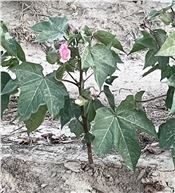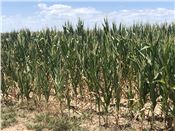Robertson: Drought Situation In Cotton ‘Could Get Real Ugly Before It Is Over’
MARY HIGHTOWER
LITTLE ROCK, ARKANSAS
Arkansas’ cotton may look decent now but continued high temperatures could really hit farmers in the pocketbook, Bill Robertson, extension cotton agronomist for the University of Arkansas System Division of Agriculture, said on Tuesday.
“While we are hanging on right now on our irrigated cotton, I am very concerned that as temperatures increase later in the month as expected we could be setting ourselves up for a repeat of 1995 with an extended period of high nighttime temperatures,” he said. “There are no management practices we can employ to compensate for high nighttime temperatures and its impact on seed set and fiber development.”
According to Monday’s crop report from the National Agricultural Statistics Service, 80 percent of the state’s cotton was rated good to excellent, down slightly from 82 percent during the weeks of June 13 and 21.
For bolls to set, the flowers on the cotton plant have to be pollinated. Heat interferes with pollination.
“After we get into flowering is where the high temps really get into our pocketbook,” Robertson said.
Heat, seeds and fiber
Nighttime temperatures of 86 degrees Fahrenheit or greater strain pollination in cotton. In 1995 there was an extended period of high nighttime temperatures which “resulted in five-lock bolls having 20 or 25 seed per boll as opposed to the norm of 35 to 38 seeds” and fewer seeds mean less fiber.
High temperatures also can affect fiber development in the boll. The goal for cotton growers is a boll with long, fine fibers. “Staple” describes the length of fibers and “micronaire,” is the width of the fiber in cross-section.
“Fiber elongation is impacted resulting in a shorter fiber and the fibers become thicker,” Robertson said “In 1995 we saw that twice as many bolls were required to produce a bale of cotton resulting in much lower-than-expected yields. Discounts associated with short-staple and high-micronaire fiber in conjunction with lower yields significantly impacted revenue.”
Robertson said that dryland, or unirrigated cotton, “is taking it on the chin right now. Time will tell what becomes of that.”
“Weed control, fertilizer, and fuel for pumping water are expenses that are up significantly from last year and are quickly adding up,” he said. “This thing could get real ugly before it is over.”
Corn
“Corn is a mixed bag right now,” said Jason Kelley, extension wheat and feed grains agronomist.
"Trying to keep up on irrigation is currently our biggest challenge with the high temperatures and lack of rainfall we have experienced over the last 30-plus days," he said.
"The corn crop uses the greatest amount of water from one to two weeks prior to tassel to three to four weeks after tasseling," Kelley said. "Unfortunately, the time of greatest water usage by the crop has aligned with our high temperatures and lack of rainfall, so the crop this year is more heavily reliant on irrigation water than in previous years. "
Kelley said areas of central and Northeast Arkansas have seen little to no rainfall for more than 30 days, while parts of Southeast Arkansas did receive some timely rains.
"Most of the crop has completed silking and now in grain fill stages, so irrigation is still very important to maximize yield," he said.
"Early planted corn in South Arkansas should be approaching maturity in late July, while later planted corn in central and Northeast Arkansas still has a way to go before reaching maturity in early to mid-August. Long term forecasts call for continued high temperatures and limited rainfall."
Monday’s NASS crop report showed the percentage of corn rated good to excellent at 67 percent the week of July 11 after peaking at 78 percent the weeks of June 13 and June 21. ∆
MARY HIGHTOWER: University of Arkansas

Taken July 13, 2022, this image shows a short plant with flowers near the top. The dryland, or non-irrigated, cotton planted two weeks later is much shorter and really bad. Extension Cotton Agronomist Bill Robertson said he expected a significant amount of dryland cotton to be abandoned this year.
U of A System Division of Agriculture photo by Bill Robertson

Stressed corn in a field near Clover Bend, Arkansas, in Lawrence County.
U of A System Division of Agriculture photo by Bryce Baldridge